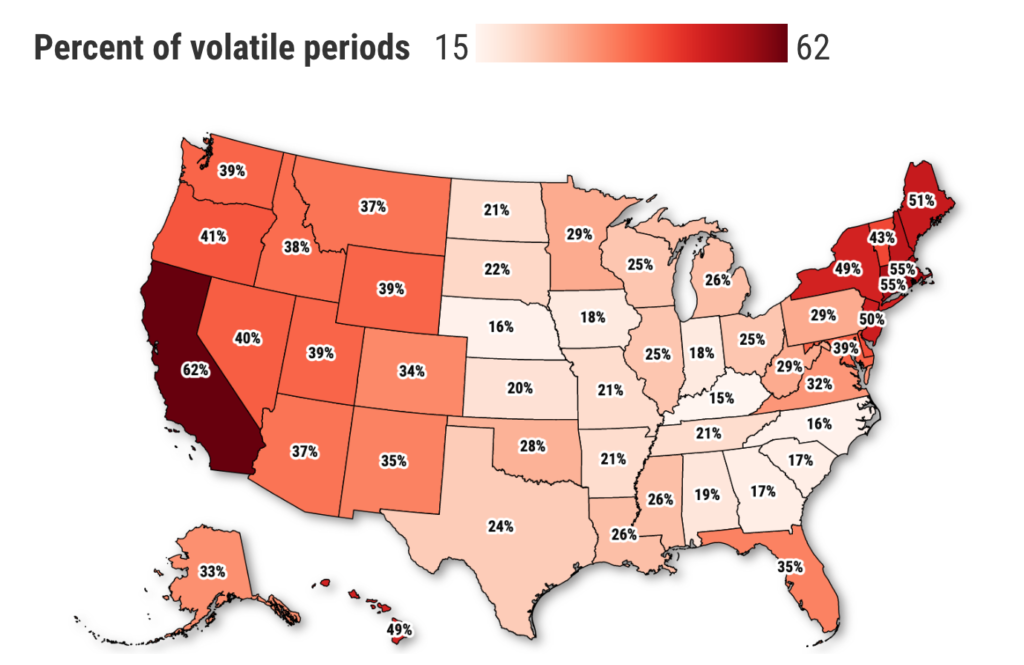
The “Looking Glass” ponders economic and real estate trends through two distinct lenses: the pessimist’s “glass half-empty” and the optimist’s “glass half-full.”
Buzz: House hunters who think California’s housing market is a tad crazy should note that it’s been the nation’s wildest market — and its second-most profitable — for nearly a half-century.
Source: My trusty spreadsheet reviewed 47 years’ worth of the Federal Housing Finance Agency’s “all-transactions” price reports for the states and the District of Columbia. This curious price index analyzes sales results plus valuations gleaned from appraisals on refinanced mortgages bought by government-support agencies.
To measure market volatility, each state’s 185 four-quarter timeframes since 1975 were studied to find two valuation extremes — periods of 10% gains or more and spans when prices declined by any amount. The frequency of these extreme swings was tracked by state.
Glass half-empty
California has had 69 four-quarter periods with double-digit price gains (the most in the nation) since 1975. Plus, there have been 46 periods of depreciation (No. 4 among the states).
That adds up to a volatility index showing a 62% chance of either pricing extreme over the past 47 years. That’s a higher level of valuation swings than any other state and nearly double the national norm of 32%.
The next wildest state was Rhode Island at 58%, Connecticut and Massachusetts at 55%, and New Hampshire at 52%.
Related Articles
Lansner’s mailbag: Can housing bubbles just fizzle out?
Where have owners rushed to list homes for sale? California ranks No. 7
Orange County adds 20 million-dollar ZIPs, loses 17 bargain neighborhoods
Where in California did owners rush to list homes for sale?
Why renters are willing to live in expensive big cities like LA, San Francisco
The least volatile market, by this math, was Kentucky at 15%; then North Carolina and Nebraska at 16%; and Georgia and South Carolina at 17%.
Oh, and California’s economic rivals? Texas was No. 37 at 24% and Florida was 22nd at 35%.
Glass half-full
History says the antacids should be part of any California homebuyer’s move-in kit, especially in an era when various online home-tracking services can give regular updates on a home’s valuation changes.
But those gyrations have brought more gains.
Since 1975, this California price index rose at a 6.7% annualized rate based — second-best in the nation. U.S. gains ran 4.6% over 47 years.
First in the nation was DC at 6.9%, and after California came Washington at 6.5%, Massachusetts and Oregon at 6%.
The smallest gains were found in Mississippi at 3.3%, then West Virginia, Arkansas, and Alabama at 3.8% and Ohio at 3.9%.
Rival Texas was No. 26 at 4.6% and Florida was No. 16 at 5.1%.
What’s ahead
Over the past half-century, California’s overall economy has morphed from a fast-growth jobs engine into the nation’s largest — and slower-growing — business machine.
Those business swings haven’t always been smooth, adding to housing volatility. And the inability of the state’s housing stock to keep up with California’s erratic but expansionary economic pace can also amplify price fluctuations.
Economic theory says investors expect to be compensated for volatility — so premium California home profits could be adding yet another challenge to the statewide housing affordability crunch.
The weight of the profit-generating gyrations, however, may be taking a toll.
Yes, California home prices gained 21% in the four quarters ended in March. But that bounty was only the 16th-largest among the states.
Jonathan Lansner is the business columnist for the Southern California News Group. He can be reached at jlansner@scng.com
